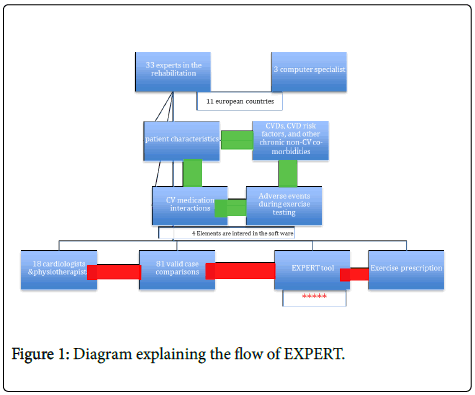Commentary Open Access
EXPERT: Did We Get Lastly the Tool
Kinsara AJ*
Director of Cardiology Fellowship, King Saud bin Abdulaziz University for Health Sciences, COM-J, Saudi Arabia
- *Corresponding Author:
- Kinsara AJ
Director of Cardiology Fellowship
King Saud bin Abdulaziz University for Health Sciences
COM-J, Saudi Arabia
Tel: 966-2-624 0000, ext. 25797
Fax: 920008668
E-mail: Kinsaraaj@ngha.med.sa
Received date: May 10, 2017; Accepted date: May 23, 2017; Published date: May 29, 2017
Citation: Kinsara AJ (2017) EXPERT: Did We Get Lastly the Tool. J Card Pulm Rehabil 1:106.
Copyright: © 2017 Kinsara AJ. This is an open-access article distributed under the terms of the Creative Commons Attribution License, which permits unrestricted use, distribution, and reproduction in any medium, provided the original author and source are credited.
Visit for more related articles at Journal of Cardiac and Pulmonary Rehabilitation
Abstract
A comprehensive training and decision support system (the EXPERT tool) had been recently developed. The tool integrates risk factors, types appropriate, medications and many other tools with the hope to make it easier and accessible to many healthcare providers in the field of cardiac rehabilitation.
Keywords
EXPERT; Interactive algorithm; Cardiac rehabilitation
Commentary
Cardiac rehabilitation was given class 1 indication but still under prescribed [1,2]. Many reasons lie behind including physician’s ability to prescribe the appropriate frequency, time, duration, intensity, and the concern of safety. The issue is complicated even more by having many risk factors that influence the quality and quantity of exercise. European 2016 guidelines for cardiovascular prevention had recommended 1000–2000 kcal per week of energy expenditure of and recommended that resistance exercise to compliment exercise training of moderate intensity twice per week [1]. Neuromotor training is also recommended in specific indications.
With this complexity, having different guidelines and cardiac rehabilitation (CR) of different types, the idea of a digital system was a dream that seems had come to be a fact, and the so called EXPERT had been recently published [3]. European Association of Preventive Cardiology Exercise Prescription in Everyday Practice and Rehabilitative Training tool (EXPERT) Group started this tool by defining the diagnostic criteria for different cardiac diseases, risk factors, and exercise intervention goals. The tool had also incorporated in addition to patient characteristics, cardiovascular disease/risk factors, common cardiac medications, and its adverse events that might occurred during exercise. An interactive algorithm was generated to prescribe cardiac exercise based on the above model by 33 experts in the rehabilitation and three computer specialists from 11 European countries. The algorithm developed over 3-year period that addresses different ranges of exercise intensity (Figure 1).
It was noticed that the prescribed exercise intensities by the clinicians were very often not match the recommended intensity, strength-training exercises, and additional exercise training strategies were prescribed less frequently, and the rehabilitation program duration was often shorter when compared to the EXPERT tool advice. EXPERT validated among 18 cardiologists and physiotherapists expert in CV rehabilitation who agreed to propose exercise training modalities for 5 simulated cases.
It will be in addition, a tool to collect large amount of data on exercise prescription and behavioral changes in cardiovascular risk factors from different countries who might use the system in their daily clinical practice and benefited from its unique decision support system.
What is left is to study the benefits in daily practice and to see if it is a cost effective tool. The cost saving might become more pronounced when it is applied on outpatient/home-based CR programs.
Another model but uses a human factor is the Project Leonardo that evaluated the introduction of "care manager" nurses, trained in this specialized role into the primary healthcare system. The central targeted 1,160 patients living with cardiovascular disease, diabetes, heart failure, and/or at risk of cardiovascular disease to take a more active role in their health. With the support of dedicated software for data collection and care management decision making, Leonardo showed the positive impact of integrated software on patient health in the primary health care system [4].
References
- Piepoli MF, Hoes AW, Agewall S, Albus C, Brotons C, et al. (2016) European Guidelines on Cardiovascular Disease Prevention in Clinical practice: The Sixth Joint Task Force of the European Society of Cardiology and Other Societies on Cardiovascular Disease Prevention in Clinical Practice (constituted by representatives of 10 societies and by invited experts) Developed with the special contribution of the European Association for Cardiovascular Prevention and Rehabilitation (EACPR) Atherosclerosis 252: 207-274.
- Benzer W, Rauch B, Schmid JP, Zwisler AD, Dendale P, et al. (2017) EuroCaReD study group. Exercise-based Cardiac Rehabilitation in Twelve European Countries Results of the European Cardiac Rehabilitation Registry. Int J Cardiol 228: 58-67.
- Hansen D, Dendale P, Coninx K, Vanhees L, Piepoli MF, et al. (2017) The European Association of Preventive Cardiology Exercise Prescription in Everyday Practice and Rehabilitative Training (EXPERT) Tool: A Digital Training and Decision Support System for Optimized Exercise Prescription in Cardiovascular Disease. Concept, Definitions and Construction Methodology. Eur J Prev Cardiol 1: 2047487317702042.
- Ciccone MM, Aquilino A, Cortese F, Scicchitano P, Sassara M, et al. (2010) Feasibility and Effectiveness Of A Disease and Care Management Model in the Primary Healthcare System For Patients with Heart Failure and Diabetes (Project Leonardo). Vasc Health Risk Manag 6: 297-305.
Relevant Topics
- Cardiac Health Exercise
- Cardiac Rehabilitation Programs
- Cardiac Rehabilitation Services
- Cardiomyopathy Disease
- Cardiopulmonary Rehab
- Cardiorespiratory Endurance
- Cardiovascular Prevention
- Cardiovascular Rehabilitation
- Chronic Obstructive Pulmonary Disease (COPD)
- Coronary Angioplasty
- Coronary Mortality
- Coronary Revascularization
- Exercise-based Cardiac Rehabilitation
- Global Cardiovascular Risk
- Heart Wise Exercise Programs
- Intensive Cardiac Rehabilitation
- Post Cardiac Rehabilitation
- Pulmonary Rehabilitation (PR)
- Secondary Prevention
- Tele Rehabilitation
- Vascular Rehabilitation
- Vestibular Rehabilitation (VR)
Recommended Journals
Article Tools
Article Usage
- Total views: 2524
- [From(publication date):
June-2017 - Jul 18, 2025] - Breakdown by view type
- HTML page views : 1670
- PDF downloads : 854

